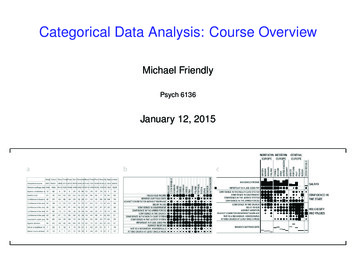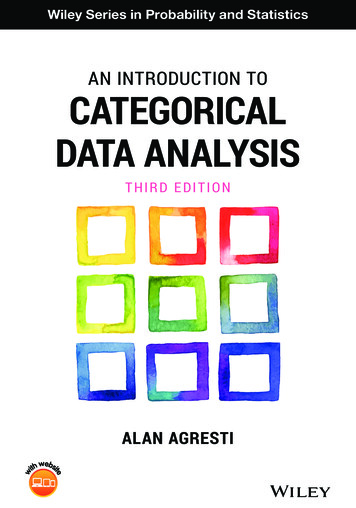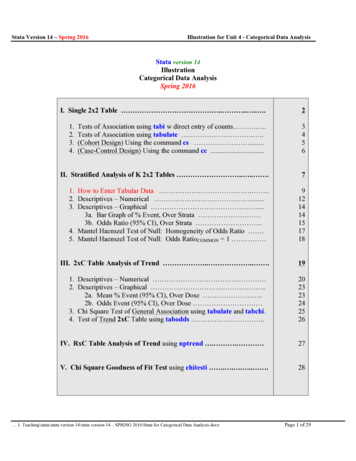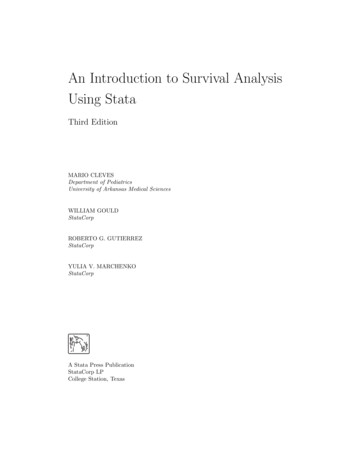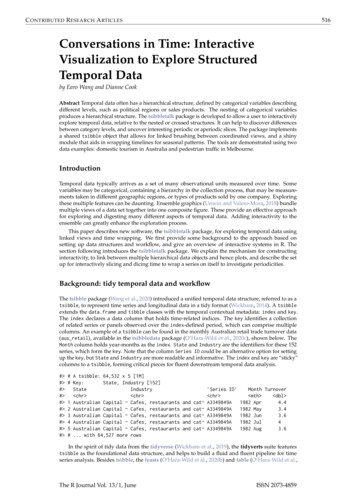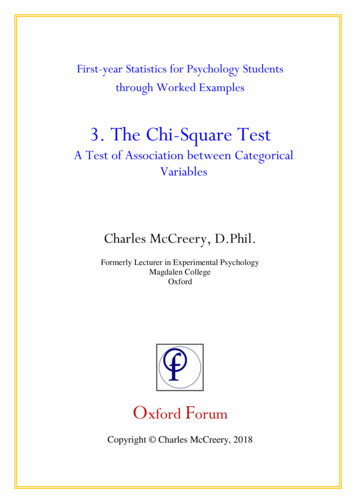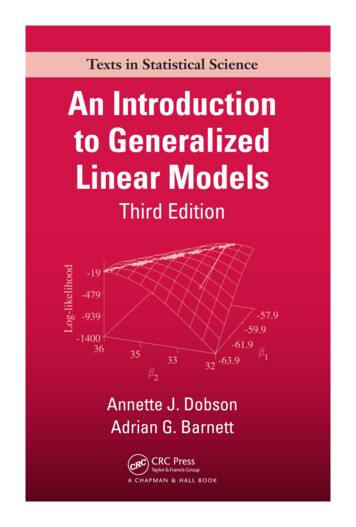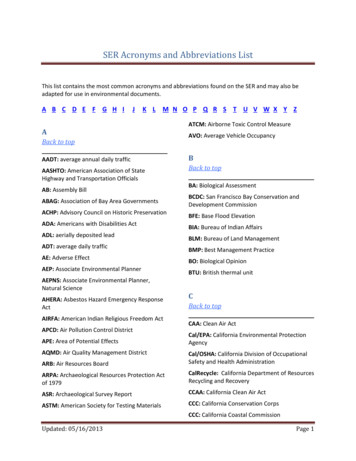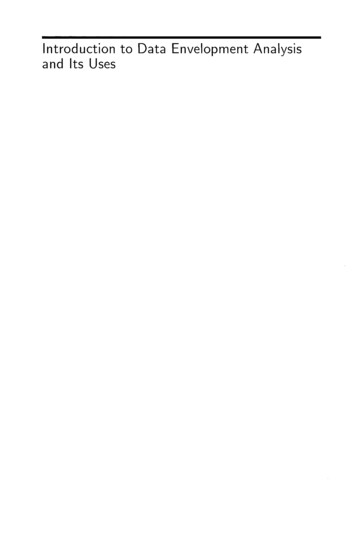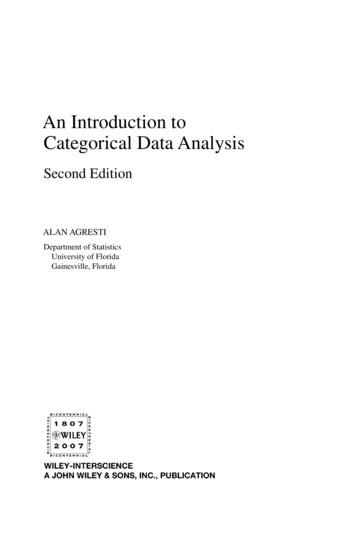
Transcription
An Introduction toCategorical Data AnalysisSecond EditionALAN AGRESTIDepartment of StatisticsUniversity of FloridaGainesville, Florida
An Introduction toCategorical Data Analysis
An Introduction toCategorical Data AnalysisSecond EditionALAN AGRESTIDepartment of StatisticsUniversity of FloridaGainesville, Florida
Copyright 2007 by John Wiley & Sons, Inc., All rights reserved.Published by John Wiley & Sons, Inc., Hoboken, New JerseyPublished simultaneously in CanadaNo part of this publication may be reproduced, stored in a retrieval system, or transmitted in any form orby any means, electronic, mechanical, photocopying, recording, scanning, or otherwise, except aspermitted under Section 107 or 108 of the 1976 United States Copyright Act, without either the priorwritten permission of the Publisher, or authorization through payment of the appropriate per-copy fee tothe Copyright Clearance Center, Inc., 222 Rosewood Drive, Danvers, MA 01923, (978) 750-8400, fax(978) 750-4470, or on the web at www.copyright.com. Requests to the Publisher for permission shouldbe addressed to the Permissions Department, John Wiley & Sons, Inc., 111 River Street, Hoboken, NJ07030, (201) 748-6011, fax (201) 748-6008, or online at http://www.wiley.com/go/permission.Limit of Liability/Disclaimer of Warranty: While the publisher and author have used their best efforts inpreparing this book, they make no representations or warranties with respect to the accuracy orcompleteness of the contents of this book and specifically disclaim any implied warranties ofmerchantability or fitness for a particular purpose. No warranty may be created or extended by salesrepresentatives or written sales materials. The advice and strategies contained herein may not be suitablefor your situation. You should consult with a professional where appropriate. Neither the publisher norauthor shall be liable for any loss of profit or any other commercial damages, including but not limited tospecial, incidental, consequential, or other damages.For general information on our other products and services or for technical support, please contact ourCustomer Care Department within the United States at (800) 762-2974, outside the United States at (317)572-3993 or fax (317) 572-4002.Wiley also publishes its books in a variety of electronic formats. Some content that appears in print maynot be available in electronic formats. For more information about Wiley products, visit our web site atwww.wiley.com.Library of Congress Cataloging-in-Publication DataAgresti, AlanAn introduction to categorical data analysis / Alan Agresti.p. cm.Includes bibliographical references and index.ISBN 978-0-471-22618-51. Multivariate analysis. I. Title.QA278.A355 1996519.5’35 - - dc222006042138Printed in the United States of America.10987654321
ContentsPreface to the Second Edition1.xvIntroduction11.1Categorical Response Data, 11.1.1 Response/Explanatory Variable Distinction, 21.1.2 Nominal/Ordinal Scale Distinction, 21.1.3 Organization of this Book, 31.2 Probability Distributions for Categorical Data, 31.2.1 Binomial Distribution, 41.2.2 Multinomial Distribution, 51.3 Statistical Inference for a Proportion, 61.3.1 Likelihood Function and Maximum Likelihood Estimation, 61.3.2 Significance Test About a Binomial Proportion, 81.3.3 Example: Survey Results on Legalizing Abortion, 81.3.4 Confidence Intervals for a Binomial Proportion, 91.4 More on Statistical Inference for Discrete Data, 111.4.1 Wald, Likelihood-Ratio, and Score Inference, 111.4.2 Wald, Score, and Likelihood-Ratio Inference forBinomial Parameter, 121.4.3 Small-Sample Binomial Inference, 131.4.4 Small-Sample Discrete Inference is Conservative, 141.4.5 Inference Based on the Mid P -value, 151.4.6 Summary, 16Problems, 162.Contingency Tables2.121Probability Structure for Contingency Tables, 212.1.1 Joint, Marginal, and Conditional Probabilities, 222.1.2 Example: Belief in Afterlife, 22v
viCONTENTS2.1.3 Sensitivity and Specificity in Diagnostic Tests, 232.1.4 Independence, 242.1.5 Binomial and Multinomial Sampling, 252.2 Comparing Proportions in Two-by-Two Tables, 252.2.1 Difference of Proportions, 262.2.2 Example: Aspirin and Heart Attacks, 262.2.3 Relative Risk, 272.3 The Odds Ratio, 282.3.1 Properties of the Odds Ratio, 292.3.2 Example: Odds Ratio for Aspirin Use and Heart Attacks, 302.3.3 Inference for Odds Ratios and Log Odds Ratios, 302.3.4 Relationship Between Odds Ratio and Relative Risk, 322.3.5 The Odds Ratio Applies in Case–Control Studies, 322.3.6 Types of Observational Studies, 342.4 Chi-Squared Tests of Independence, 342.4.1 Pearson Statistic and the Chi-Squared Distribution, 352.4.2 Likelihood-Ratio Statistic, 362.4.3 Tests of Independence, 362.4.4 Example: Gender Gap in Political Affiliation, 372.4.5 Residuals for Cells in a Contingency Table, 382.4.6 Partitioning Chi-Squared, 392.4.7 Comments About Chi-Squared Tests, 402.5 Testing Independence for Ordinal Data, 412.5.1 Linear Trend Alternative to Independence, 412.5.2 Example: Alcohol Use and Infant Malformation, 422.5.3 Extra Power with Ordinal Tests, 432.5.4 Choice of Scores, 432.5.5 Trend Tests for I 2 and 2 J Tables, 442.5.6 Nominal–Ordinal Tables, 452.6 Exact Inference for Small Samples, 452.6.1 Fisher’s Exact Test for 2 2 Tables, 452.6.2 Example: Fisher’s Tea Taster, 462.6.3 P -values and Conservatism for Actual P (Type I Error), 472.6.4 Small-Sample Confidence Interval for Odds Ratio, 482.7 Association in Three-Way Tables, 492.7.1 Partial Tables, 492.7.2 Conditional Versus Marginal Associations: DeathPenalty Example, 492.7.3 Simpson’s Paradox, 512.7.4 Conditional and Marginal Odds Ratios, 522.7.5 Conditional Independence Versus Marginal Independence, 532.7.6 Homogeneous Association, 54Problems, 55
viiCONTENTS3.Generalized Linear Models653.1Components of a Generalized Linear Model, 663.1.1 Random Component, 663.1.2 Systematic Component, 663.1.3 Link Function, 663.1.4 Normal GLM, 673.2 Generalized Linear Models for Binary Data, 683.2.1 Linear Probability Model, 683.2.2 Example: Snoring and Heart Disease, 693.2.3 Logistic Regression Model, 703.2.4 Probit Regression Model, 723.2.5 Binary Regression and Cumulative DistributionFunctions, 723.3 Generalized Linear Models for Count Data, 743.3.1 Poisson Regression, 753.3.2 Example: Female Horseshoe Crabs and their Satellites, 753.3.3 Overdispersion: Greater Variability than Expected, 803.3.4 Negative Binomial Regression, 813.3.5 Count Regression for Rate Data, 823.3.6 Example: British Train Accidents over Time, 833.4 Statistical Inference and Model Checking, 843.4.1 Inference about Model Parameters, 843.4.2 Example: Snoring and Heart Disease Revisited, 853.4.3 The Deviance, 853.4.4 Model Comparison Using the Deviance, 863.4.5 Residuals Comparing Observations to the Model Fit, 873.5 Fitting Generalized Linear Models, 883.5.1 The Newton–Raphson Algorithm Fits GLMs, 883.5.2 Wald, Likelihood-Ratio, and Score Inference Use theLikelihood Function, 893.5.3 Advantages of GLMs, 90Problems, 904.Logistic Regression4.1Interpreting the Logistic Regression Model, 994.1.1 Linear Approximation Interpretations, 1004.1.2 Horseshoe Crabs: Viewing and Smoothing a BinaryOutcome, 1014.1.3 Horseshoe Crabs: Interpreting the Logistic RegressionFit, 1014.1.4 Odds Ratio Interpretation, 10499
viiiCONTENTS4.1.54.1.6Logistic Regression with Retrospective Studies, 105Normally Distributed X Implies Logistic Regressionfor Y , 1054.2 Inference for Logistic Regression, 1064.2.1 Binary Data can be Grouped or Ungrouped, 1064.2.2 Confidence Intervals for Effects, 1064.2.3 Significance Testing, 1074.2.4 Confidence Intervals for Probabilities, 1084.2.5 Why Use a Model to Estimate Probabilities?, 1084.2.6 Confidence Intervals for Probabilities: Details, 1084.2.7 Standard Errors of Model Parameter Estimates, 1094.3 Logistic Regression with Categorical Predictors, 1104.3.1 Indicator Variables Represent Categories of Predictors, 1104.3.2 Example: AZT Use and AIDS, 1114.3.3 ANOVA-Type Model Representation of Factors, 1134.3.4 The Cochran–Mantel–Haenszel Test for 2 2 KContingency Tables, 1144.3.5 Testing the Homogeneity of Odds Ratios, 1154.4 Multiple Logistic Regression, 1154.4.1 Example: Horseshoe Crabs with Color and WidthPredictors, 1164.4.2 Model Comparison to Check Whether a Term is Needed, 1184.4.3 Quantitative Treatment of Ordinal Predictor, 1184.4.4 Allowing Interaction, 1194.5 Summarizing Effects in Logistic Regression, 1204.5.1 Probability-Based Interpretations, 1204.5.2 Standardized Interpretations, 121Problems, 1215.Building and Applying Logistic Regression Models5.15.2137Strategies in Model Selection, 1375.1.1 How Many Predictors Can You Use?, 1385.1.2 Example: Horseshoe Crabs Revisited, 1385.1.3 Stepwise Variable Selection Algorithms, 1395.1.4 Example: Backward Elimination for Horseshoe Crabs, 1405.1.5 AIC, Model Selection, and the “Correct” Model, 1415.1.6 Summarizing Predictive Power: Classification Tables, 1425.1.7 Summarizing Predictive Power: ROC Curves, 1435.1.8 Summarizing Predictive Power: A Correlation, 144Model Checking, 1445.2.1 Likelihood-Ratio Model Comparison Tests, 1445.2.2 Goodness of Fit and the Deviance, 145
ixCONTENTS5.2.3Checking Fit: Grouped Data, Ungrouped Data, andContinuous Predictors, 1465.2.4 Residuals for Logit Models, 1475.2.5 Example: Graduate Admissions at University of Florida, 1495.2.6 Influence Diagnostics for Logistic Regression, 1505.2.7 Example: Heart Disease and Blood Pressure, 1515.3 Effects of Sparse Data, 1525.3.1 Infinite Effect Estimate: Quantitative Predictor, 1525.3.2 Infinite Effect Estimate: Categorical Predictors, 1535.3.3 Example: Clinical Trial with Sparse Data, 1545.3.4 Effect of Small Samples on X 2 and G2 Tests, 1565.4 Conditional Logistic Regression and Exact Inference, 1575.4.1 Conditional Maximum Likelihood Inference, 1575.4.2 Small-Sample Tests for Contingency Tables, 1585.4.3 Example: Promotion Discrimination, 1595.4.4 Small-Sample Confidence Intervals for LogisticParameters and Odds Ratios, 1595.4.5 Limitations of Small-Sample Exact Methods, 1605.5 Sample Size and Power for Logistic Regression, 1605.5.1 Sample Size for Comparing Two Proportions, 1615.5.2 Sample Size in Logistic Regression, 1615.5.3 Sample Size in Multiple Logistic Regression, 162Problems, 1636.Multicategory Logit Models6.16.26.3Logit Models for Nominal Responses, 1736.1.1 Baseline-Category Logits, 1736.1.2 Example: Alligator Food Choice, 1746.1.3 Estimating Response Probabilities, 1766.1.4 Example: Belief in Afterlife, 1786.1.5 Discrete Choice Models, 179Cumulative Logit Models for Ordinal Responses, 1806.2.1 Cumulative Logit Models with Proportional OddsProperty, 1806.2.2 Example: Political Ideology and Party Affiliation, 1826.2.3 Inference about Model Parameters, 1846.2.4 Checking Model Fit, 1846.2.5 Example: Modeling Mental Health, 1856.2.6 Interpretations Comparing Cumulative Probabilities, 1876.2.7 Latent Variable Motivation, 1876.2.8 Invariance to Choice of Response Categories, 189Paired-Category Ordinal Logits, 189173
xCONTENTS6.3.1 Adjacent-Categories Logits, 1906.3.2 Example: Political Ideology Revisited, 1906.3.3 Continuation-Ratio Logits, 1916.3.4 Example: A Developmental Toxicity Study, 1916.3.5 Overdispersion in Clustered Data, 1926.4 Tests of Conditional Independence, 1936.4.1 Example: Job Satisfaction and Income, 1936.4.2 Generalized Cochran–Mantel–Haenszel Tests, 1946.4.3 Detecting Nominal–Ordinal Conditional Association, 1956.4.4 Detecting Nominal–Nominal Conditional Association, 196Problems, 1967.Loglinear Models for Contingency Tables7.17.27.37.4204Loglinear Models for Two-Way and Three-Way Tables, 2047.1.1 Loglinear Model of Independence for Two-Way Table, 2057.1.2 Interpretation of Parameters in Independence Model, 2057.1.3 Saturated Model for Two-Way Tables, 2067.1.4 Loglinear Models for Three-Way Tables, 2087.1.5 Two-Factor Parameters Describe ConditionalAssociations, 2097.1.6 Example: Alcohol, Cigarette, and Marijuana Use, 209Inference for Loglinear Models, 2127.2.1 Chi-Squared Goodness-of-Fit Tests, 2127.2.2 Loglinear Cell Residuals, 2137.2.3 Tests about Conditional Associations, 2147.2.4 Confidence Intervals for Conditional Odds Ratios, 2147.2.5 Loglinear Models for Higher Dimensions, 2157.2.6 Example: Automobile Accidents and Seat Belts, 2157.2.7 Three-Factor Interaction, 2187.2.8 Large Samples and Statistical vs Practical Significance, 218The Loglinear–Logistic Connection, 2197.3.1 Using Logistic Models to Interpret Loglinear Models, 2197.3.2 Example: Auto Accident Data Revisited, 2207.3.3 Correspondence Between Loglinear and Logistic Models, 2217.3.4 Strategies in Model Selection, 221Independence Graphs and Collapsibility, 2237.4.1 Independence Graphs, 2237.4.2 Collapsibility Conditions for Three-Way Tables, 2247.4.3 Collapsibility and Logistic Models, 2257.4.4 Collapsibility and Independence Graphs for MultiwayTables, 2257.4.5 Example: Model Building for Student Drug Use, 2267.4.6 Graphical Models, 228
xiCONTENTS7.5Modeling Ordinal Associations, 2287.5.1 Linear-by-Linear Association Model, 2297.5.2 Example: Sex Opinions, 2307.5.3 Ordinal Tests of Independence, 232Problems, 2328.Models for Matched Pairs8.1244Comparing Dependent Proportions, 2458.1.1 McNemar Test Comparing Marginal Proportions, 2458.1.2 Estimating Differences of Proportions, 2468.2 Logistic Regression for Matched Pairs, 2478.2.1 Marginal Models for Marginal Proportions, 2478.2.2 Subject-Specific and Population-Averaged Tables, 2488.2.3 Conditional Logistic Regression for Matched-Pairs, 2498.2.4 Logistic Regression for Matched Case–Control Studies, 2508.2.5 Connection between McNemar andCochran–Mantel–Haenszel Tests, 2528.3 Comparing Margins of Square Contingency Tables, 2528.3.1 Marginal Homogeneity and Nominal Classifications, 2538.3.2 Example: Coffee Brand Market Share, 2538.3.3 Marginal Homogeneity and Ordered Categories, 2548.3.4 Example: Recycle or Drive Less to Help Environment?, 2558.4 Symmetry and Quasi-Symmetry Models for Square Tables, 2568.4.1 Symmetry as a Logistic Model, 2578.4.2 Quasi-Symmetry, 2578.4.3 Example: Coffee Brand Market Share Revisited, 2578.4.4 Testing Marginal Homogeneity Using Symmetry andQuasi-Symmetry, 2588.4.5 An Ordinal Quasi-Symmetry Model, 2588.4.6 Example: Recycle or Drive Less?, 2598.4.7 Testing Marginal Homogeneity Using Symmetry andOrdinal Quasi-Symmetry, 2598.5 Analyzing Rater Agreement, 2608.5.1 Cell Residuals for Independence Model, 2618.5.2 Quasi-independence Model, 2618.5.3 Odds Ratios Summarizing Agreement, 2628.5.4 Quasi-Symmetry and Agreement Modeling, 2638.5.5 Kappa Measure of Agreement, 2648.6 Bradley–Terry Model for Paired Preferences, 2648.6.1 The Bradley–Terry Model, 2658.6.2 Example: Ranking Men Tennis Players, 265Problems, 266
xii9.CONTENTSModeling Correlated, Clustered Responses2769.1Marginal Models Versus Conditional Models, 2779.1.1 Marginal Models for a Clustered Binary Response, 2779.1.2 Example: Longitudinal Study of Treatments forDepression, 2779.1.3 Conditional Models for a Repeated Response, 2799.2 Marginal Modeling: The GEE Approach, 2799.2.1 Quasi-Likelihood Methods, 2809.2.2 Generalized Estimating Equation Methodology: BasicIdeas, 2809.2.3 GEE for Binary Data: Depression Study, 2819.2.4 Example: Teratology Overdispersion, 2839.2.5 Limitations of GEE Compared with ML, 2849.3 Extending GEE: Multinomial Responses, 2859.3.1 Marginal Modeling of a Clustered Multinomial Response, 2859.3.2 Example: Insomnia Study, 2859.3.3 Another Way of Modeling Association with GEE, 2879.3.4 Dealing with Missing Data, 2879.4 Transitional Modeling, Given the Past, 2889.4.1 Transitional Models with Explanatory Variables, 2889.4.2 Example: Respiratory Illness and Maternal Smoking, 2889.4.3 Comparisons that Control for Initial Response, 2899.4.4 Transitional Models Relate to Loglinear Models, 290Problems, 29010.Random Effects: Generalized Linear Mixed Models29710.1 Random Effects Modeling of Clustered Categorical Data, 29710.1.1 The Generalized Linear Mixed Model, 29810.1.2 A Logistic GLMM for Binary Matched Pairs, 29910.1.3 Example: Sacrifices for the Environment Revisited, 30010.1.4 Differing Effects in Conditional Models and MarginalModels, 30010.2 Examples of Random Effects Models for Binary Data, 30210.2.1 Small-Area Estimation of Binomial Probabilities, 30210.2.2 Example: Estimating Basketball Free Throw Success, 30310.2.3 Example: Teratology Overdispersion Revisited, 30410.2.4 Example: Repeated Responses on Similar Survey Items, 30510.2.5 Item Response Models: The Rasch Model, 30710.2.6 Example: Depression Study Revisited, 30710.2.7 Choosing Marginal or Conditional Models, 30810.2.8 Conditional Models: Random Effects Versus ConditionalML, 309
CONTENTSxiii10.3 Extensions to Multinomial Responses or Multiple Random EffectTerms, 31010.3.1 Example: Insomnia Study Revisited, 31010.3.2 Bivariate Random Effects and Association Heterogeneity, 31110.4 Multilevel (Hierarchical) Models, 31310.4.1 Example: Two-Level Model for Student Advancement, 31410.4.2 Example: Grade Retention, 31510.5 Model Fitting and Inference for GLMMS, 31610.5.1 Fitting GLMMs, 31610.5.2 Inference for Model Parameters and Prediction, 317Problems, 31811. A Historical Tour of Categorical Data Analysis32511.1 The Pearson–Yule Association Controversy, 32511.2 R. A. Fisher’s Contributions, 32611.3 Logistic Regression, 32811.4 Multiway Contingency Tables and Loglinear Models, 32911.5 Final Comments, 331Appendix A: Software for Categorical Data Analysis332Appendix B: Chi-Squared Distribution Values343Bibliography344Index of Examples346Subject Index350Brief Solutions to Some Odd-Numbered Problems357
Preface to the Second EditionIn recent years, the use of specialized statistical methods for categorical data hasincreased dramatically, particularly for applications in the biomedical and socialsciences. Partly this reflects the development during the past few decades ofsophisticated methods for analyzing categorical data. It also reflects the increasing methodological sophistication of scientists and applied statisticians, most ofwhom now realize that it is unnecessary and often inappropriate to use methodsfor continuous data with categorical responses.This book presents the most important methods for analyzing categorical data. Itsummarizes methods that have long played a prominent role, such as chi-squaredtests. It gives special emphasis, however, to modeling techniques, in particular tologistic regression.The presentation in this book has a low technical level and does not require familiarity with advanced mathematics such as calculus or matrix algebra. Readers shouldpossess a background that includes material from a two-semester statistical methodssequence for undergraduate or graduate nonstatistics majors. This background shouldinclude estimation and significance testing and exposure to regression modeling.This book is designed for students taking an introductory course in categorical dataanalysis, but I also have written it for applied statisticians and practicing scientistsinvolved in data analyses. I hope that the book will be helpful to analysts dealing withcategorical response data in the social, behavioral, and biomedical sciences, as wellas in public health, marketing, education, biological and agricultural sciences, andindustrial quality control.The basics of categorical data analysis are covered in Chapters 1–8. Chapter 2surveys standard descriptive and inferential methods for contingency tables, such asodds ratios, tests of independence, and conditional vs marginal associations. I feelthat an understanding of methods is enhanced, however, by viewing them in thecontext of statistical models. Thus, the rest of the text focuses on the modeling ofcategorical responses. Chapter 3 introduces generalized linear models for binary dataand count data. Chapters 4 and 5 discuss the most important such model for binomial(binary) data, logistic regression. Chapter 6 introduces logistic regression modelsxv
xviPREFACE TO THE SECOND EDITIONfor multinomial responses, both nominal and ordinal. Chapter 7 discusses loglinearmodels for Poisson (count) data. Chapter 8 presents methods for matched-pairs data.I believe that logistic regression is more important than loglinear models, sincemost applications with categorical responses have a single binomial or multinomialresponse variable. Thus, I have given main attention to this model in these chaptersand in later chapters that discuss extensions of this model. Compared with the firstedition, this edition places greater emphasis on logistic regression and less emphasison loglinear models.I prefer to teach categorical data methods by unifying their models with ordinaryregression and ANOVA models. Chapter 3 does this under the umbrella of generalizedlinear models. Some instructors might prefer to cover this chapter rather lightly, usingit primarily to introduce logistic regression models for binomial data (Sections 3.1and 3.2).The main change from the first edition is the addition of two chapters dealing withthe analysis of clustered correlated categorical data, such as occur in longitudinalstudies with repeated measurement of subjects. Chapters 9 and 10 extend the matchedpairs methods of Chapter 8 to apply to clustered data. Chapter 9 does this withmarginal models, emphasizing the generalized estimating equations (GEE) approach,whereas Chapter 10 uses random effects to model more fully the dependence. Thetext concludes with a chapter providing a historical perspective of the developmentof the methods (Chapter 11) and an appendix showing the use of SAS for conductingnearly all methods presented in this book.The material in Chapters 1–8 forms the heart of an introductory course in categorical data analysis. Sections that can be skipped if desired, to provide more time forother topics, include Sections 2.5, 2.6, 3.3 and 3.5, 5.3–5.5, 6.3, 6.4, 7.4, 7.5, and8.3–8.6. Instructors can choose sections from Chapters 9–11 to supplement the basictopics in Chapters 1–8. Within sections, subsections labelled with an asterisk are lessimportant and can be skipped for those wanting a quick exposure to the main points.This book is of a lower technical level than my book Categorical Data Analysis(2nd edition, Wiley, 2002). I hope that it will appeal to readers who prefer a moreapplied focus than that book provides. For instance, this book does not attempt toderive likelihood equations, prove asymptotic distributions, discuss current researchwork, or present a complete bibliography.Most methods presented in this text require extensive computations. For themost part, I have avoided details about complex calculations, feeling that computing software should relieve this drudgery. Software for categorical data analysesis widely available in most large commercial packages. I recommend that readers of this text use software wherever possible in answering homework problemsand checking text examples. The Appendix discusses the use of SAS (particularly PROC GENMOD) for nearly all methods discussed in the text. The tablesin the Appendix and many of the data sets analyzed in the book are available atthe web site http://www.stat.ufl.edu/ aa/intro-cda/appendix.html. The web sitehttp://www.stat.ufl.edu/ aa/cda/software.html contains information about the useof other software, such as S-Plus and R, Stata, and SPSS, including a link to an excellent free manual prepared by Laura Thompson showing how to use R and S-Plus to
PREFACE TO THE SECOND EDITIONxviiconduct nearly all the examples in this book and its higher-level companion. Alsolisted at the text website are known typos and errors in early printings of the text.I owe very special thanks to Brian Marx for his many suggestions about the text overthe past 10 years. He has been incredibly generous with his time in providing feedbackbased on using the book many times in courses. He and Bernhard Klingenberg alsovery kindly reviewed the draft for this edition and made many helpful suggestions.I also thank those individuals who commented on parts of the manuscript or whomade suggestions about examples or material to cover. These include Anna Gottardfor suggestions about Section 7.4, Judy Breiner, Brian Caffo, Allen Hammer, andCarla Rampichini. I also owe thanks to those who helped with the first edition, especially Patricia Altham, James Booth, Jane Brockmann, Brent Coull, Al DeMaris,Joan Hilton, Peter Imrey, Harry Khamis, Svend Kreiner, Stephen Stigler, and LarryWinner. Thanks finally to those who helped with material for my more advanced text(Categorical Data Analysis) that I extracted here, especially Bernhard Klingenberg,Yongyi Min, and Brian Caffo. Many thanks to Stephen Quigley at Wiley for hiscontinuing interest, and to the Wiley staff for their usual high-quality support.As always, most special thanks to my wife, Jacki Levine, for her advice andencouragement. Finally, a truly nice byproduct of writing books is the opportunity toteach short courses based on them and spend research visits at a variety of institutions.In doing so, I have had the opportunity to visit about 30 countries and meet manywonderful people. Some of them have become valued friends. It is to them that Idedicate this book.ALAN AGRESTILondon, United KingdomJanuary 2007
CHAPTER 1IntroductionFrom helping to assess the value of new medical treatments to evaluating the factorsthat affect our opinions on various controversial issues, scientists today are findingmyriad uses for methods of analyzing categorical data. It’s primarily for thesescientists and their collaborating statisticians – as well as those training to performthese roles – that this book was written. The book provides an introduction to methodsfor analyzing categorical data. It emphasizes the ideas behind the methods and theirinterpretations, rather than the theory behind them.This first chapter reviews the probability distributions most often used for categorical data, such as the binomial distribution. It also introduces maximum likelihood,the most popular method for estimating parameters. We use this estimate and arelated likelihood function to conduct statistical inference about proportions. Webegin by discussing the major types of categorical data and summarizing the book’soutline.1.1CATEGORICAL RESPONSE DATALet us first define categorical data. A categorical variable has a measurement scaleconsisting of a set of categories. For example, political philosophy may be measuredas “liberal,” “moderate,” or “conservative”; choice of accommodation might usecategories “house,” “condominium,” “apartment”; a diagnostic test to detect e-mailspam might classify an incoming e-mail message as “spam” or “legitimate e-mail.”Categorical scales are pervasive in the social sciences for measuring attitudes andopinions. Categorical scales also occur frequently in the health sciences, for measuringresponses such as whether a patient survives an operation (yes, no), severity of aninjury (none, mild, moderate, severe), and stage of a disease (initial, advanced).Although categorical variables are common in the social and health sciences, theyare by no means restricted to those areas. They frequently occur in the behavioralAn Introduction to Categorical Data Analysis, Second Edition. By Alan AgrestiCopyright 2007 John Wiley & Sons, Inc.1
2INTRODUCTIONsciences (e.g., categories “schizophrenia,” “depression,” “neurosis” for diagnosis oftype of mental illness), public health (e.g., categories “yes” and “no” for whetherawareness of AIDS has led to increased use of condoms), zoology (e.g., categories“fish,” “invertebrate,” “reptile” for alligators’ primary food choice), education (e.g.,categories “correct” and “incorrect” for students’ responses to an exam question),and marketing (e.g., categories “Brand A,” “Brand B,” and “Brand C” for consumers’preference among three leading brands of a product). They even occur in highlyquantitative fields such as engineering sciences and industrial quality control, whenitems are classified according to whether or not they conform to certain standards.1.1.1Response/Explanatory Variable DistinctionMost statistical analyses distinguish between response variables and explanatoryvariables. For instance, regression models describe how the distribution of acontinuous response variable, such as annual income, changes according to levelsof explanatory variables, such as number of years of education and number of yearsof job experience. The response variable is sometimes called the dependent variable or Y variable, and the explanatory variable is sometimes called the independentvariable or X variable.The subject of this text is the analysis of categorical response variables. Thecategorical variables listed in the previous subsection are response variables. In somestudies, they might also serve as explanatory variables. Statistical models for categorical response variables analyze how such responses are influenced by explanatoryvariables. For example, a model for political philosophy could use predictors such asannual income, attained education, religious affiliation, age, gender, and race. Theexplanatory variables can be categorical or continuous.1.1.2Nominal/Ordinal Scale DistinctionCategorical variables have two main types of measurement scales. Many categoricalscales have a natural ordering. Examples are attitude toward legalization of abortion(disapprove in all cases, approve only in certain cases, approve in all cases), appraisalof a company’s inventory level (too low, about right, too high), response to a medicaltreatment (excellent, good, fair, poor), and frequency of feeling symptoms of anxiety(never, occasionally, often, always). Categorical variables having ordered scales arecalled ordinal variables.Categorical variables having unordered scales are called nominal variables. Examples are religious affiliation (categories Catholic, Jewish, Protestant, Muslim, other),primary mode of transportation
2.4 Chi-Squared Tests of Independence, 34 2.4.1 Pearson Statistic and the Chi-Squared Distribution, 35 2.4.2 Likelihood-Ratio Statistic, 36 2.4.3 Tests of Independence, 36 2.4.4 Example: Gender Gap in PoliticalAffiliation, 37 2.4.5 Residuals for Cells in a Contingency Table, 38 2.4.6 Partitioning Chi-Squared, 39 2.4.7 CommentsAbout Chi-Squared .
